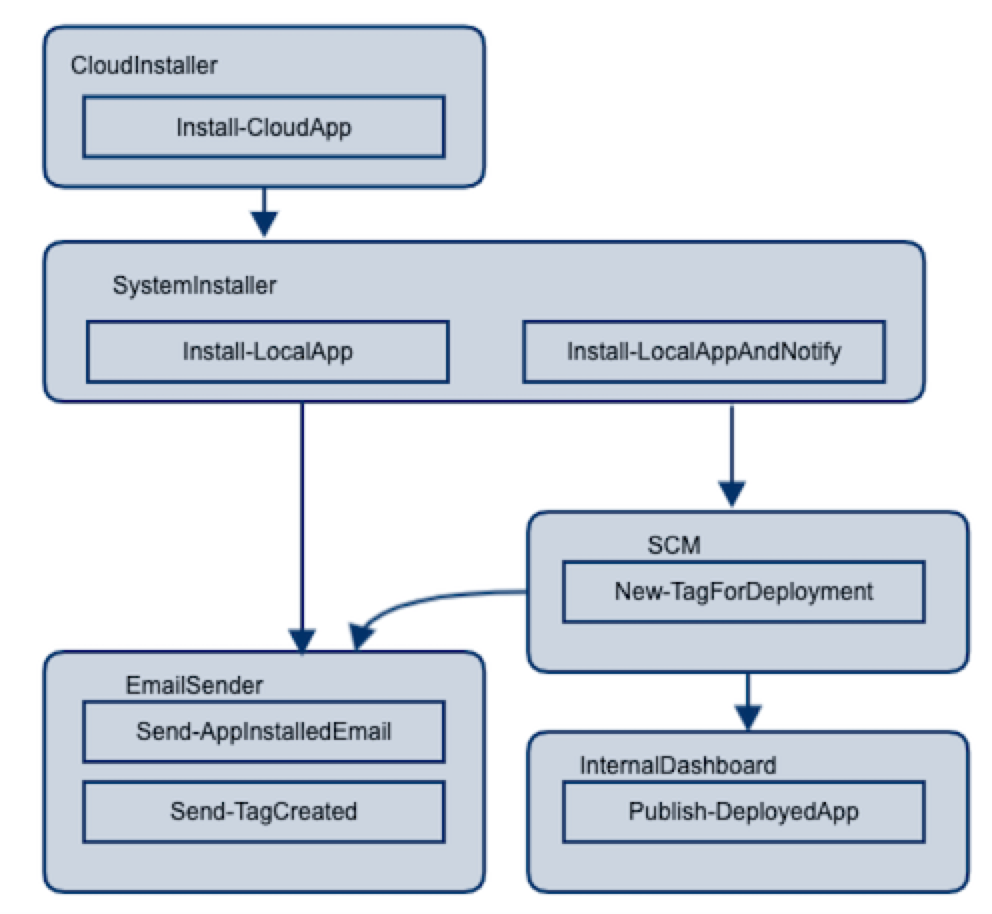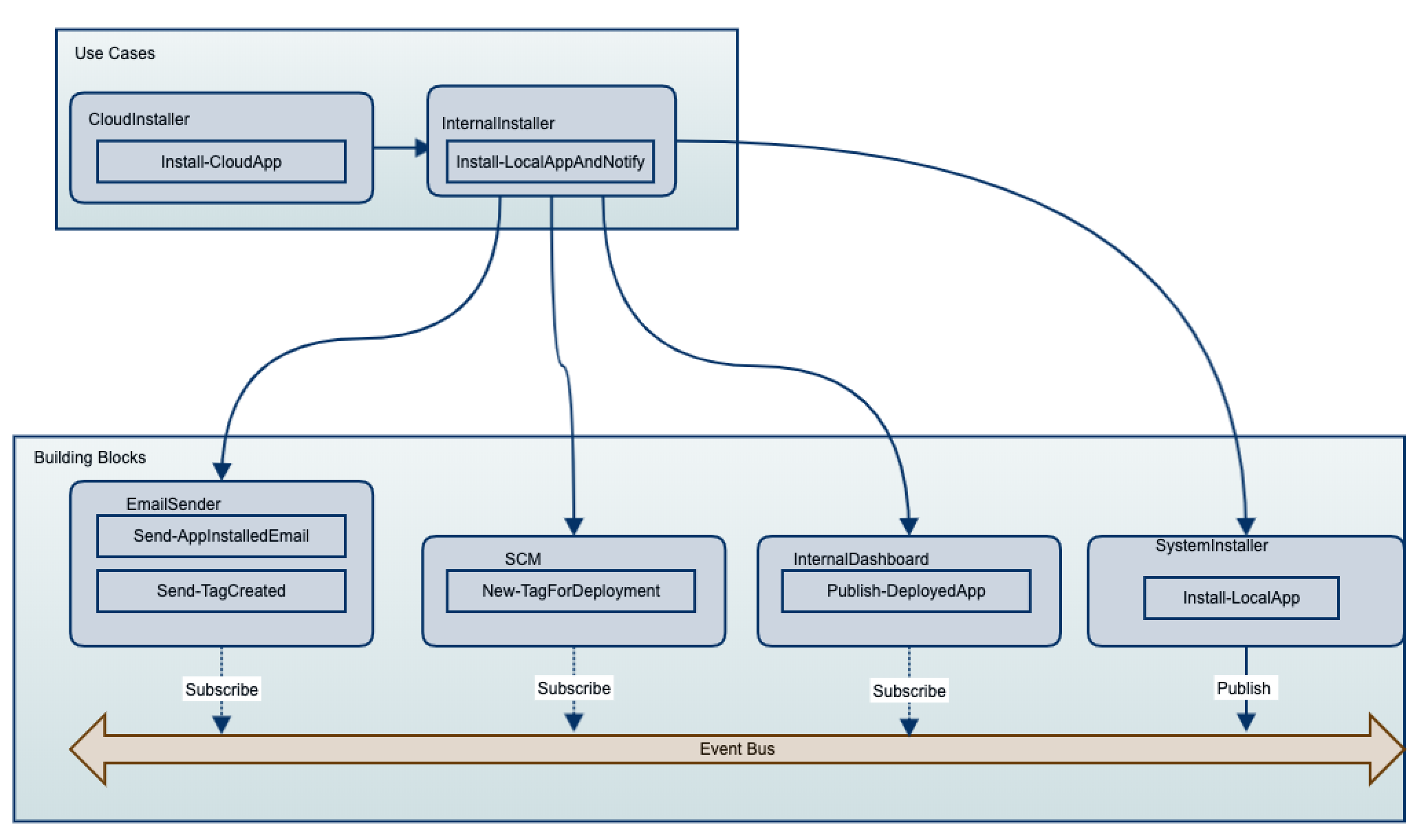Decouple Your Powershell Modules Using Events
(Source Code is available in this GithHub repository)
Powershell Modules
When building a code base of any language, we want to keep the code organised in encapsulated modules. This enable the code to be testable, maintainable and reusable
Powershell offers several ways of organising the code, but the most used is to organise them in Modules. A module in Powershell can include a Manifest file that declares (among other details) the Modules that this Module depends on. This dependencies will be pre-loaded when the target Module is loaded.
For .Net development, this is similar to dependencies declared in NUget packages.
The Manifest .psd1 file is comparable to the .nuspec file in NUget.
Why decoupling?
Even with a tidy organisation of Modules, code reuse and modularity start to show their ugly face: dependency hell
In particular, this article is concerned with two of the problems identified as a side effect of modularity:
-
Many dependencies
-
Long chain of dependencies
Too many (unwanted) dependencies loaded
First attempts at code modularisation do, at some point, fall short in specificity.
A module that deals with, for example, deploying an application to an environment, could end up loading modules that are not needed for that specific use case.

For example, figure 1 shows a 4-tier hierarchy of dependencies between modules.
The module SystemInstaller installs software in the current machine (cloud or on premises).
One commandlet in this module needs to tag the source code when software is ready to be tested.
When this happens, the SCM module updates an internal Dashboard.
Loading SystemInstaller will also load SCM, InternalDashoard and EmailSender modules.
But if we need to just call Install-LocalApp we will only need EmailSender.
These modules may be used in different occasions and scenarios. The combination of these use cases will very likely result in highly coupled modules like in this example, or sometimes much worse.
Long chain of dependencies
Another side effect of loading unwanted modules is that we will also load the dependencies of these unwanted modules.
As time passes, more dependencies are loaded to these transitive dependencies and….one day we find out that loading one module ends up loading 20 modules, of which we only need one or two.
This takes up time consumes resources…and it can have unwanted side effects in your environment, such as installing software or writing to the file system.
Decoupling Powershell modules with Events
A better module organisation is to have a "flatter" hierarchical structure. The top-level modules represent specific use cases, where the lower level are the building blocks.
Developers can use the building blocks provided they use get-help and understand the extent of a module.
Here is a representation of a flat hierarchy of modules for the previous graph.

In this model, Top Level modules can be thought as mediators of the building blocks. They represent the top level use case that knows what are the different building blocks in place.
Dealing with Email Servers, Source Control Management Systems and Dashboards are all independent of each other. Use cases that need one of these libraries, will import the modules and "wire" them together in a publish-and-subscribe approach.
Powershell support for events is neither widely used nor documented, but the language provides the building blocks necessary to implement such pattern.
Implementation: Using events to decouple modules
Building blocks
The EmailSender and InternalDashboard modules have no dependencies.
Their input parameters can be simple primitives like strings or integers.
This make these building block modules very easy to test and develop.
function Send-TagCreatedEmail($tag,$to){
write-host "[EmailSender]**** Sending Email to $to. Message: 'CREATED TAG $tag' ****"
}function Publish-DeployedApp($appId,$deploymentId){
write-host "[InternalDashboard]***** Publishing Deployment $deploymentId to dashboard ******"
}Event Publishers
SystemInstaller and SCM modules are also building blocks with no dependencies.
Hence, they are also easy to develop, test and reuse.
These two modules also publish events when their goal is completed.
The events are called AppInstalled and TagCreated respectively.
function Install-LocalApp($appId){
$deploymentId = Get-Random -Maximum 100
write-host "[SystemInstaller]***** Intalling app with id $appId. Deployment Id: $deploymentId"
New-Event -SourceIdentifier AppInstalled `
-MessageData @{appId = $appId; deploymentId= $deploymentId}|out-null
}function New-TagForDeployment($deploymentId){
write-host "[SCM]**** Creating Tag for deploymentId $deploymentId******"
New-Event -SourceIdentifier TagCreated `
-MessageData @{Tag = "DEPLOYED/$deploymentId"}|out-null
}Both modules are raising an event to the Powershell’s internal event bus.
This is done using New-Event Powershell cmdlet, which is only available from version 6.0.
|
Events wouldn’t be too useful without additional context data. But this means that subscribers to the event need to know how to parse this data, specially when the values are complex types. This is also a type of coupling, which is why is a good idea to keep events with little data and simple structure. |
Event Subscriber
Finally, the top level script will load all building block modules and "connect" their events from some of them to the commands in others.
We need to setup three event listeners:
-
When
AppInstalledoccurs, we publish the news to theInternalDashboard -
Also, we need to tag the source code using the
SCMmodule -
Finally, when the
SCMmodule publishesTagCreated, members of the Test teams need to be notified by email, so that they can start testing.
Adding subscribers to Powershell events is done with the Register-EngineEvent commandlet.
|
The former allows listening for events raised within Powershell. |
After wiring these events, we proceed with the action: install an application locally.
Import-Module SCM
Import-Module InternalDashboard
Import-Module EmailSender
Import-Module SystemInstaller
function Install-LocalAppAndNotify($appId){
# When App is Installed, Publish to the Dashboard
Register-EngineEvent -SourceIdentifier AppInstalled `
-Action {
InternalDashboard\Publish-DeployedApp `
-appId $event.messagedata.appId `
-deploymentId $event.messagedata.deploymentId
}|Out-Null
# ... and create a tag in source control
Register-EngineEvent -SourceIdentifier AppInstalled `
-Action {
SCM\New-TagForDeployment `
-deploymentId $event.messagedata.deploymentId
}|Out-Null
# Email testers when the tag is created
Register-EngineEvent -SourceIdentifier TagCreated `
-Action {
EmailSender\Send-TagCreatedEmail `
-tag $event.messagedata.Tag `
-to 'Testers@myorg.com'
}|Out-Null
# Now install the application
write-host "[InternalInstaller]**** Starting Installation "
SystemInstaller\Install-LocalApp -appId $appId
#Do not forget to remove event listeners!!
Get-EventSubscriber| Remove-Event
}When we run this top level script, the end result is as desired. we execute it this way:
$env:PSMODULEPATH = $pwd
Import-Module InternalInstaller
Install-LocalAppAndNotify 42This is the console output. Notice that the event publish and subscribe pattern is running synchronously
[InternalInstaller]**** Starting Installation
[SystemInstaller]***** Intalling app with id 42. Deployment Id: 60
[InternalDashboard]***** Publishing Deployment 60 to dashboard ******
[SCM]**** Creating Tag for deploymentId 60******
[EmailSender]**** Sending Email to Testers@myorg.com. Message: 'CREATED TAG DEPLOYED/60' ****